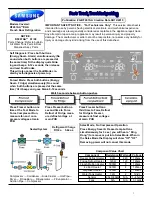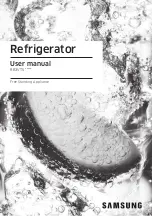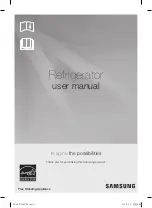
32
BEFORE YOU CALL
Visit our web site at
www.frigidaire.com.
1-800-944-9044 (United States)
1-800-265-8352 (Canada)
CONCERN
POTENTIAL CAUSE
COMMON SOLUTION
AUTOMATIC ICE MAKER
Ice maker is not mak-
ing any ice.
•
Ice maker is turned off.
•
Refrigerator is not connected to wa-
ter line or water valve is not open.
•
The water supply line is kinked.
• The water filter is not seated
properly.
• The water filter may be clogged
with foreign material.
•
Saddle valve on cold water pipe
is clogged or restricted by foreign
material.
•
Turn on ice maker. For the fresh food ice maker, press and
hold the “Ice Off” button for 4 seconds until the indicator turns
off. For the freezer ice maker, lower the wire signal arm.
•
Connect the unit to the household water supply and ensure
the supply valve is open.
•
Ensure that the supply line does not kink when the refrigera-
tor is pushed into place against the wall.
• Remove and re-install the water filter. Be sure to push the
filter firmly so that you hear it lock solidly into position.
• If water dispenses slowly or not at all, or if the filter is six (6)
months old or older, it should be replaced.
•
Turn off household water line valve. Remove valve. Ensure
that valve is not a self-piercing saddle valve. Clean valve.
Replace valve if necessary.
Ice maker is not mak-
ing enough ice.
•
Ice maker is producing less ice
than you expect.
• The water filter may be clogged
with foreign material.
•
The water supply line is kinked.
•
Saddle valve on cold water pipe
is clogged or restricted by foreign
material.
•
The fresh food and freezer ice makers will each produce
approximately 2.5 pounds of ice every 24 hours depending
on usage conditions.
• If water dispenses slower than normal, or if the filter is six
(6) months old or older, it should be replaced.
•
Ensure that the supply line does not kink when the refrigera-
tor is pushed into place against the wall.
•
Turn off household water line valve. Remove valve. Ensure
that valve is not a self-piercing saddle valve. Clean valve.
Replace valve if necessary.
Freezer ice maker will
not stop making ice.
•
Ice maker wire signal arm is be-
ing held down by some package
in the freezer that has fallen
against the ice maker.
•
Move the item and release wire signal arm. Remove any ice
cubes that may have frozen together over the wire signal
arm.
Ice cubes are freezing
together.
•
Ice cubes are not being used
frequently enough.
•
Ice cubes are hollow (shells of
ice with water inside). The hollow
cubes break open in the bin and
leak their water onto existing ice,
which causes it to freeze together.
•
Remove ice container and discard ice. The ice maker will
produce fresh supply. Ice should be used at least twice
weekly to keep the cubes separated.
•
This generally occurs when the ice maker does not get
enough water. This is usually the result of a clogged water
filter. Replace the water filter.
ICE DISPENSER
Dispenser will not dis-
pense ice.
•
There is no ice in the bin to be
dispensed.
•
The refrigerator doors are not com-
pletely closed.
•
Dispenser paddle has been pressed
too long and the dispenser motor
has overheated.
•
See the “Ice maker is not making any ice” section above.
•
Be sure the refrigerator doors are completely closed.
•
The motor overload protector will reset in about three (3)
minutes and then ice can be dispensed.
Ice dispenser is
jammed.
•
Ice has melted and frozen around au-
ger due to infrequent use, temperature
fluctuations, and/or power outages.
•
Ice cubes are jammed between ice
maker and back of ice container.
•
Remove ice container, thaw, and empty the contents. Clean
container, wipe dry, and replace in proper position. When
new ice is made, dispenser should operate.
•
Remove ice cubes that are jamming the dispenser.
OPENING/CLOSING OF DOORS/DRAWERS
Door(s) will not close.
•
Door was closed too hard, causing
other door to open slightly.
•
Refrigerator is not level. It rocks
on the floor when moved slightly.
•
Refrigerator is touching a wall or
cabinet.
•
Close both doors gently.
• Ensure floor is level and solid, and can adequately support the re
-
frigerator. Contact a carpenter to correct a sagging or sloping floor.
• Ensure floor is level and solid, and can adequately support the re
-
frigerator. Contact a carpenter to correct a sagging or sloping floor.
Drawers are difficult to
move.
•
Food is touching shelf on top of
drawer.
•
Track that drawers slide on is dirty.
•
Remove top layer of items in drawer.
•
Ensure drawer is properly installed on track.
•
Clean drawer, rollers, and track. See Care & Cleaning.



































